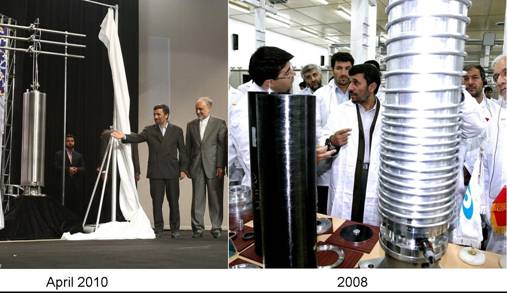click on the image for a larger version

Iranian president Ahmadinejad unveiled the new IR-2 centrifuge on 11 April 2010 after having viewed it during its development stage in 2008.
Unveiling is in quotes because we have, of course, seen these centrifuges before: President Ahmadinejad viewed them in April 2008; during the 2nd Nuclear Festival Day. These were the IR-2 centrifuges and an initial test batch was installed at the Pilot Fuel Enrichment Facility at Natanz in January 2008. At that time, there were 11 such machines undergoing testing. Ten were arranged in a cascade and one was operating on its own.
The IR-2 is said to be based on the second generation Pakistani machine, the P-2, but with a carbon fiber rotor instead of the maraging rotor Pakistan used. As we have discussed before, Iran does have considerable academic and practical experience with carbon fiber forms. I won’t even begin to try to guess the enrichment capacity of this machine; we have had so many discussions on the capacity of the IR-1 and arrived at so many different numbers that it hardly seems worthwhile. For all you fellow timeline addicts, I would say that this announcement does seem to set an upper limit for how long it takes Iran to run the final development tests at about 27 months. It’s not clear if that includes production run tests or not but I would guess that it does. Of course, it’s very likely that these tests were finished before this and that the Iranian president waited until the Fourth Nuclear Festival Day to announce them. But that’s why 27 months is an upper limit!
It is also important to keep in mind that these machines were tested at Natanz. That is where Iran’s experts at setting up centrifuges work. When and if we see new centrifuge designs being developed at other sites—such as the facility near Qom—we will know that Iran has reproduced its centrifuge operational expertise at other facilities. That will be an important proliferation milestone!
Update 13 April 2010, 13:30 ISIS has done a much more complete analysis of the unveiled Iranian centrifuge and and conclude that it is a new type and not the IR-2 I assumed. (I note that wonk-readers Omid and Pedro also came to this conclusion.) This post is, however, about testing timelines and unless the quote from Iranian Atomic Energy Organization head Ali Akbar Salehi is wrong (“The mass production of second-generation centrifuges will begin in the coming months”), Iran still takes about 27 months to complete development/production testing.

Oh,it can be a good discussion!
I think the centrifuges are IR-4’s.They called it 3rd generation and told it has the capacity of 10 kgSWU/yr and has 6 times capacity of IR-1 which they say have a capacity of 1.8 kgSWU/yr(that we think they don’t work full time for any reason) and 2 times capacity of 2nd generation(IR-2,IR-2m and IR-3) and you know IR-4’s are the last centrifuges being tested at Natanz.
Omid,
You certainly could have the advantage on me by listening to the original Persian. The article on NTI’s website, however, states: “The mass production of second-generation centrifuges will begin in the coming months,” Iranian Atomic Energy Organization head Ali Akbar Salehi said. I interpret that to mean either the IR-2 or the IR-3. (However, I suspect that the IR-3 is just an IR-2 that evolved during development testing since they are said to differ by the design of the extraction scoops.) That doesn’t preclude, of course, that the centrifuge unveiled during the ceremony was an IR-4, a machine I have never seen a picture of. It just strikes me as a little strange if it was. Some superficial externalities, moreover, match up the the IR-2 Mr. Ahmadinejad was viewing back in 2008.
I don’t think that this machine is even an IR-4; it should be the IR-5 or even 6.
The machine is much larger than the IR-2.
The IR-2 should have been the first generation of carbon-fiber machines, running sub-critically.
This new third gen. machine on the other hand is a multi-segment super-critical machine. It’s higher than the IR-2 and its rotor has a larger diameter.
They also said that it will take some two years until this machine enters production. The first step will be IR-2 production, which may replace to be installed IR-1s at Natanz in the comming months.
These new centrifuges will certainly help Iran with their legitimate quest for an independent fuel cycle, consistent with the NPT bargain. Good luck to them.
Albright claims that these have not been tested with hex (quoting head of AEOI, Salehi). Assuming his sources are correct ( because I did not see Salehi’s comment myself), then by simple deduction, we can agree with Pedro that it must be post IR4, let’s call it IR5. Why you ask? Because if you recall the last two reports of the Agency had mentioned cascades of IR4 were being tested at the PFEP with UF6.
The mystery is the speed of these IR5s. Presstv quoted 900 revolutions/sec which really does not make sense. 54,000 RPM is far lower than IR1s (i.e, 64K). But what if they meant 900 m/s, then that makes sense because if you go with Kemp’s power of 2 approximation for the speed, then going from 350 to 900 you get about 10 x increase in SWU, of course pretty rough. But if this is correct, then this is truly remarkable achievement a double segmented supercritical that is reaching the Resende’s alleged SWU performance, still below the work horse of Urenco(i.e., TC12) by a factor of 4.
“The machines have passed through mechanical tests and we expect ,based on calculations,the machines reach the capacity of 10[kgSWU/yr]“Mr.Saleshi said in the ceremony.It means they may be some other kind!
Geoff, you constantly underestimate Iran’s progress in every one of your articles, only to be proved wrong.
Doesn’t it get boring?